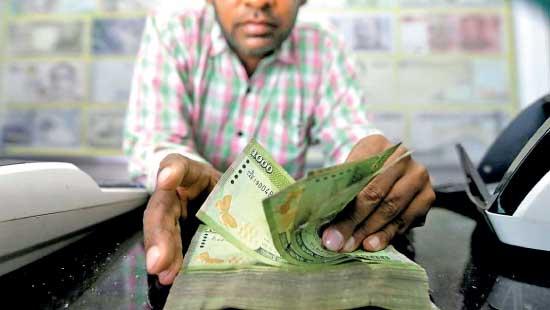06 Jul 2023 - {{hitsCtrl.values.hits}}
 By Dr. Nishan De Mel
By Dr. Nishan De Mel
It is unfortunate for the workers of Sri Lanka that private parties, politicians and bureaucrats have spotted the huge potential for colluding together and profiting off the EPF, and concealing their acts by concealing the data
We know that women are regularly abused on the streets in Sri Lanka. Would that then justify passing a law to give men explicit permission to abuse women? It seems to be that sort of argument that is now being made with regard to the EPF, by those who say that the past abuse of the EPF justifies the present DDR proposal
The private sector workers of Sri Lanka are required by law to transfer 23% of their incomes to the Employees’ Provident Fund (EPF) and the Employees’ Trust Fund (ETF) every month, towards their retirement savings. The EPF is managed by a special division within the Central Bank of Sri Lanka (CBSL), and the Monetary Board of CBSL is tasked with overall stewardship of the Fund.
Forensic audits were commissioned by the Central Bank to look into the abuse of bond transactions, as well as the EPF funds. These audits were limited to transactions that occurred prior to March 2015. Information that came to light during parliamentary hearings revealed specific transactions where the EPF was part of the nexus of ongoing “bond-scandals” in the period not covered by the forensic audit.
Report number 3 of the Forensic Audits on the Central Bank, published in 2019, exposed large losses to the EPF caused by the collective irresponsibility and corruption within the CBSL. I am not aware of any prosecutions that have been initiated to date in this regard.
The “Bond Scandal” is Covered up by Concealing Data
The full extent of that “bond-scandal” and potentially ongoing abuse of the EPF can only be discovered by getting information on the secondary market transactions of the EPF. However, the Central Bank, since 2017, has obdurately refused to share this data, despite a strong judgement against the Central Bank in November 2018 by the RTI Commission of Sri Lanka requiring them to do so.
The EPF is now a Rs. 3.4 trillion fund. It is by far the single biggest fund in Sri Lanka. Extracting even a tiny percentage, like 0.01%, of the EPF is a ticket to the billionaire’s club of the country. It is unfortunate for the workers of Sri Lanka that private parties, politicians and bureaucrats have spotted the huge potential for colluding together and profiting off the EPF, and concealing their acts by concealing the data.
Why the Instincts of Winston Churchill can help the EPF
The following well-known apocryphal story about Winston Churchill was carried in The Insider, formerly Business Insider, this way:
One day shortly after the Second World War ended, Winston Churchill and Labour Party Prime Minister Clement Attlee encountered one another at the urinal trough in the House of Common’s men’s washroom. Attlee arrived first. When Churchill arrived, he stood as far away from him as possible. Attlee said, “Feeling standoffish today, are we, Winston?” Churchill said: “That’s right. Every time you see something big, you want to nationalize it.” (source: https://www.businessinsider.com/quote-of-the-day-so-churchill-2012-5)
If there was any wisdom in that Churchillian quip, it certainly applies to the EPF. It is too big to be safe. Safeguarding the EPF will require a much higher level of protection: that means more data transparency, regular forensic audits, a publicly accountable investment committee and overall performance metrics that are reported and tracked. The current proposal for domestic debt restructuring (DDR) brings the fears of Churchill into sharp focus for the EPF.
The Central Bank’s Dereliction of Duty
The framers of the EPF’s law, however, all the way back in 1958, may have been prescient about the temptations that would arise when all the retirement savings of all the workers are gathered into one place. They stipulated the fullest level of transparency and wrote it into the law. Among many other clauses on disclosure, they also said that EPF was bound to share “a statement of investments showing the face value, purchase price, and market value of each of the investments”.
But the Central Bank has failed to adhere to this legal requirement of transparency for a long time – this issue was noted in the Judgement against the Central Bank by the Right to Information Commission of Sri Lanka in 2018. 
Since then, the Central Bank has gone one step further and misrepresented the legal requirement in its latest financial statements, writing it as “each type of investment”, and proceeding to publish aggregate figures that allow it to conceal the information that would otherwise reveal the abuse of the EPF funds, which were detected by the forensic audit of 2019.
Even the EPF annual reports tend to be years behind. Until parliamentarians questioned it in December 2022, annual reports were at least five years overdue. Annual reports for 2017, 2018 and 2019 were published only in December 2022. And the annual report for 2020 was published only in 2023. Annual reports for 2021 and 2022 are yet overdue(but the financial statements for those years have been published recently).
The 2023 Proposal for Domestic Debt Restructure (DDR)
The government of Sri Lanka set about the exercise of DDR by introducing an Orwellian phrase --domestic debt optimization (DDO). We have not seen this terminology anywhere else in the world. A technical analysis of this proposal is forthcoming in a debt update to be published by Verité Research. The long and the short of it is this: it proposes to shift the entire burden of DDR on the present and future retirement savings in the EPF for a full 16 years – until 2038.
This is a most unorthodox proposal that socializes the entire cost of DDR, and allows equity holders of banks and private bond-holders to make meteoric gains in a short space of time – because the government bonds they stocked up already had the cost of the DDR priced-in, which will now accrue as privatized profits at the expense of the EPF.
The EPF is the largest purchaser of government bonds – around 36% of the total bond issuances are held by the EPF– and those holdings generally account for over 90% of the EPF’s investments. If the EPF is professionally managed, then the weighted average returns on its bond portfolio are likely to match or exceed the weighted average returns of the overall bond issuances by the government, because yield curves are generally upward sloping and the EPF can hold a larger proportion of longer-term bonds.
Calculating the loss to current EPF balances up to 2038
In 2021, the CBSL started publishing data on the entire bond portfolio of the government. At the end of May 2023, the weighted average return in the market on government bond issuances was 13.52%. Many very high-return bonds (over 20%) are locked to the future: the weighted average yield of bonds maturing between 2027-2030 is 14.52%. The weighted average yield of bonds maturing between 2031 and 2034 is 14.43%. It is the bonds maturing prior to 2026 that have a lower average yield of 12.65%.
At this 13.52% compounded rate of return, the present EPF portfolio would grow to 25.7 trillion. But at the offered average return of 9.1% the present EPF portfolio would grow to only 13.6 trillion. The difference between these two growth paths on the current balance alone, is LKR 12.1 trillion by 2038. Discounting that by 13.52% gives a present value of 1.6 trillion, which is 47% of the present value of the EPF. This is what is now tipped to happen if the political leadership that is preventing the holding of elections gets to decide the fate of the EPF.
The above calculation of loss depends on estimating the weighted average cost of government debt stock over the next 16 years (which should also be the average yield for the EPF, barring another corruption scandal that is waiting to be revealed). But interest rates in Sri Lanka tend to move in cycles. Therefore, the current weighted average rate might on balance be an underestimate (when looking at the full-time period up to 2038). That is because after a debt restructuring episode longer term interest rates are more likely to be elevated for a longer time (than in the past). Both internal and external creditors are likely to keep Sri Lanka in a higher risk bracket for longer term debt issuances for two reasons. Firstly, countries on average restructure debt more than once before achieving sustainability – and Sri Lanka’s governance indicators put it at high risk of a second episode. Secondly, the current debt sustainability framework does not look beyond the 2032 horizon, and the solution path being proposed already looks like too much repayment stress is being pushed out into the 2033-2038 period.
Corruption and Injustice is not the path to economic recovery
It’s not nationalization (like in the case of Churchill) but corruption and injustice from which the EPF needs protection.
It is now widely discussed that the EPF has also been abused in the past to provide lower returns. We can only calculate this properly if further past data on government debt holdings is published. But this is hardly an argument to entrench that abuse in a permanent way for the next 16 years through this proposed DDR. If at all, it is an argument for urgently discovering and rectifying that past abuse as well, isn’t it?
We know that women are regularly abused on the streets in Sri Lanka. Would that then justify passing a law to give men explicit permission to abuse women? It seems to be that sort of argument that is now being made with regard to the EPF, by those who say that the past abuse of the EPF justifies the present DDR proposal.
The Central Bank, while continuing to conceal critical investment data, not publishing annual reports, not showing calculation assumptions, and not reporting the net present value loss to the EPF from its DDR proposal, is exclusively targeting the EPF to have a large chunk of the returns to people’s retirement savings eaten up in the next 16 years.
This is the most unorthodox proposal for domestic debt restructuring that I have seen in the world. It passes on the entire burden to a working population that had no choice about having a large part of their incomes placed in government bonds as retirement savings, while at the same time ensuring that all other private parties (not just banks) who knowingly priced in the risk and bought government bonds at very high yields will get monumental returns.
Churchill steered clear of Atlee for good reason. We must steer decision-making on the EPF away from the Central Bank and the current political leadership of the country, for that very same reason.
The writer is an economist and the Executive Director of Verité Research, Sri Lanka

28 Dec 2024 9 hours ago
28 Dec 2024 28 Dec 2024
28 Dec 2024 28 Dec 2024
28 Dec 2024 28 Dec 2024
28 Dec 2024 28 Dec 2024